Natural Stone Show 2017
Few, if any, exhibitions entice me more than the biennial staging of Natural Stone Show . Stone paving was my first love and so the chance to look at new developments sends a tingle right down my spine, even though I know that there is usually precious little of it to see at this show. But hey! Where else is there to go in Britain? Yes, there’s the Italian Marmomacc mega-feast each September and there are improving events in India and China, but if I want to keep my passport safely tucked up in its drawer, then the London Stone Show is the only real option.
I even understand why it’s help in the inhospitable and inconvenient ExCel: it suits the international audience, even though it’s a bloody nightmare for those of us from northern Britain, and even more so this year because the toy train set that limps along out of central London to the eastern wastes has decided to close the bloody station that serves the giant tin shed, so you’re obliged to endure until the following stop then trudge for the best part of a kilometre (with this knackered spine!) to get to the actual venue.

Still: all can be put right if there’s lots of lovely stone to gawp at and interesting people to chat with. The pre-show exhibitor list doesn’t look too promising, in truth. Yes, there’s plenty of appealing names, but so many of the wheelers and dealers for stone paving in Britain are noticeable by their absence. Is this because they see no point in promoting their home nations focussed services to an international audience, or is it that they feel the show doesn’t attract the key buyers of their products?
There’s no doubt that those producers, suppliers and assorted middle-men that do make an official appearance at the show are keenly focussed on overseas trade rather than British-based buyers, of whom there is precious little sign.

Note that term I used: " official appearance ". One of the most commonly reported gripes from exhibitors when speaking with them was the number of non-exhibiting traders who were trawling the room, touting their wares, despite not having paid a penny to attend the show and have the opportunity to speak with a dedicated audience. I can well understand how it must rankle, when you’ve forked out a few grand to have a presence at the show and then have some dodgy market-trader pester you to buy from them.
I was suddenly apprehended by some bloke from a London-based specialist cutting tool supplier, who sprang out in front of me, barring my free passage, invaded my personal space and, just centimetres from my face, began an interrogation. "Interested?", he demanded to know. I wrinkled my nose in the universal sign of ‘Not really’ and tried to move on, but he blocked my escape. "Are you English?" he demanded to know. "Irish", I replied, a little disturbed at his intrusive need to know my ethnicity. "Oh! Well done!" he sarcastically congratulated me. I thought about telling him to Feck Off, but just barged past him saying nothing more, thinking it to be just about the most ineffective and off-putting sales technique I’d encountered in a long while.
Still, it possibly had more success that that employed by the countless Chinese exhibitors who resolutely sit at their stands, their heads down, glued to their smartphone, refusing to make any eye contact and emanating an aura of ‘Please don’t talk to us’. There’s absolutely no engagement of any consequence.
I stooped to feel the texture of a bush-hammered granite. I can’t be sure, but I’m pretty certain she never broke eye contact with Facebook or whatever the state-sanctioned Chinese equivalent might be. I tried to initiate a conversation. "Hi", I said, relying on my commanding grasp of international business language. She momentarily looked up, gave me the falsest, most insincere smile possible, then went back to Facebook. Her male colleague, obviously engaged in some desperately exciting online game judging from the way he jerked and twisted in response to whatever was on his ‘phone, didn’t even look up. I tried to smile at herself, but she wasn’t paying attention, so I drifted on by.
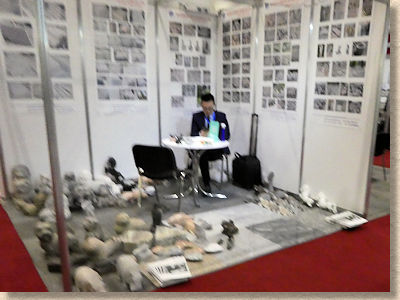
A good friend and a regular exhibitor later told me that most of the Chinese exhibitors received state grants to appear at international shows such as this and they have no real interest in promoting sales as their wage is fixed, and they get nothing extra for playing the ritual games we Westerners expect as part of a business deal. So, they don’t bother. Apparently, it’s less about being seen by western buyers and more about being seen by co-exhibiting rivals.
Exhibitors:
Of the exhibitors who were prepared to make the effort and engage in conversation, most are well known, and some are old friends, but there were a few new faces.
Welsh Slate had a very busy stand, and even the MD was on hand to respond to queries and do his bit to promote what has to be one of the most under-utilised native stones in British paving. It’s not that they aren’t aware of the glorious purple rock’s potential for paving, more that they’re constantly battling against the preconception that they only do roofing slate. They’d love to sell it as paving, but how to get the word out there to those that make such decisions?
An invite to re-visit the quarry in the very near future (it must be 6 years since I was last there) might help explore that particular conundrum. We’ll see!

McMonagle Stone , like their Welsh counterparts, are not always primarily associated with paving, and were using this show to push their Stoneer wall cladding system.
I have to confess that I thought their display was falling apart. Two ‘walls’ of the Stoneer had corner chunks missing, revealing the unattractive timber structure behind. Bugger! Who needs that at an important exhibition such as this?
It turns out my concern was unnecessary. The corner pieces had been deliberately omitted to show that the product was a cladding system and not a full thickness wall block as it so convincingly appears. Doh! Such clever marketing ploys are obviously wasted on me, but it makes a valid point.
So many of these cladding systems are on the market now, and many of them look like what they are: modular cladding. The McMonagle Stoneer is so bloody good it genuinely looks like actual, proper walling stone, even to an old cynic like me. It comes as no real surprise to hear that sales, and interest from overseas, are positively booming.
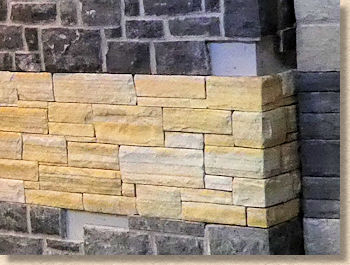
Exciting news about Jointex , the one-part brush-in jointing mortar distrubuted in Britain and Ireland by McMonagle Stone. Major changes are forthcoming but, just for a short while longer, I'm sworn to secrecy. However, I can say that, if and when it comes tio market, it'll be the big shake-up the one-part resin mortars deperately need. More news as soon as I can....
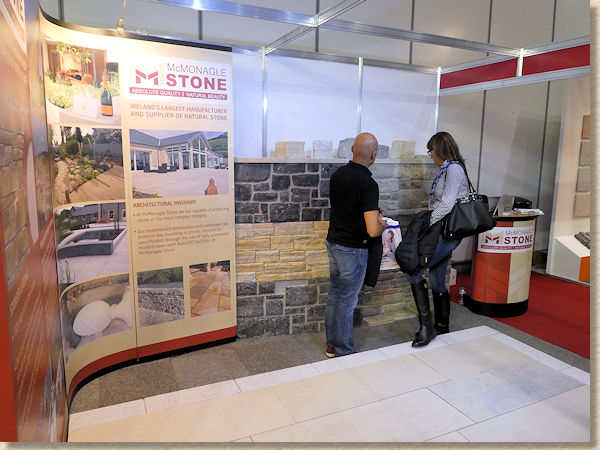
Lovell Stone Group are, quarry by quarry, muscling their way to becoming one of the most important stone suppliers in the south of England. Their recent acquisition of the iconic Bath Stone serves only to underline the key position they now occupy, and to celebrate their excitement at getting their mitts on such a well-known and internationally respected asset, they’ve launched a stonemasonry challenge, asking local students of the noble art of rock-chippery to carve a Bath icon from a chink of iconic Bath stone. And impressive they are, ranging from a miner’s head, to a sort of surreal representation of the world-renowned Georgian Crescent.
MD, Simon Hart, is rightly proud of what they’ve achieved, but he also revealed a shared concern over the lack of skilled people coming into the stone trades, whether that is quarrying, his particular area of concern, stonemasonry or even my own streetmasonry. With no proper career path to offer, just how do we attract the brighter students? If the best qualification you can acquire as a pavior is NVQ2, why would you choose that as a career? Why is it so difficult to find youngsters who are prepared to work? Why are they averse to physical graft? Simon related the recent struggle to find a suitable candidate for a well-paid, fully-supported, backed-with-college-training, apprentice position within one of their quarries. Those that do apply, apparently do so under coercion from what used to be the Labour Exchange, or they come with a misconception of what is expected: namely, they didn’t expect to have to get their hands dirty and actually break into a sweat occasionally.
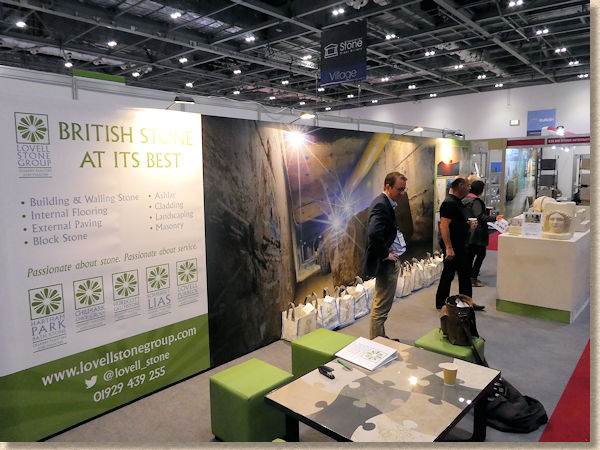
It’s a worrying time, especially when faced with the prospect of possibly losing all that skilled European labour, trained to a relatively high standard at someone else’s expense. The apprenticeships currently on offer to British workers are not fit for purpose and are used by far too many employers as a source of cheap labour rather than an investment for the future.
And an unsurprisingly similar tale from Paul Sutherland at Caithness Flagstone Ltd. - just how do we get young workers to come into this industry? We have nothing to offer them, it would seem, other than hard graft, indifferent wages, and buggerall in the way of career development. That is not a recipe for success, even when you have such a unique product as the Caithness Flagstone.
Paul was showing some of the ‘display’ pieces they were carving from the unmistakeable Scottish rock using their new CNC machine; plates, beakers, quaiches and more….but what he’d really like is a skilled and enthusiastic workforce, not just in the quarry up there are the very tip of mainland Britain, but out on site where so few understand the intricacies of laying such a distinctive and delicious form of paving.
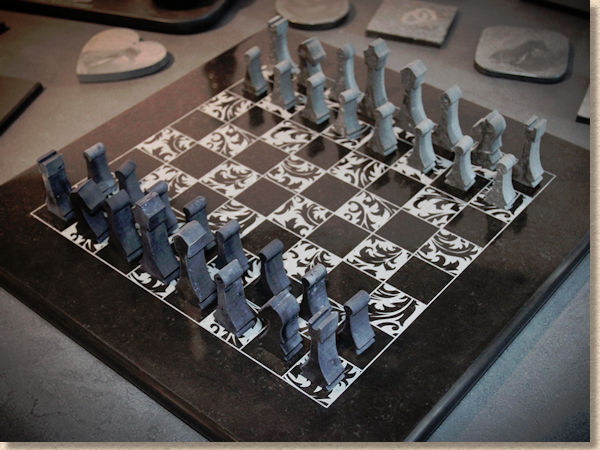
Johnson Wellfield are a long-time supporter of the Stone Show, and while the personnel may be new to me, the creamily gorgeous Crosland Hill yorkstone is as reassuringly reliable as ever.
With there being so much interest in stone paving for public and commercial schemes at the moment, I’d expected to see more representation from the Pennines, but, for reasons best known to themselves, the others decided to leave the field completely open to Huddersfield’s finest. At a time when the native stone trade is being assaulted from every direction by imported stone, you’d think that Yorkstone, being the one native stone we have that truly excels, and which has demonstrable export potential, would be making its presence felt, so well done and big thanks to Johnson Wellfield for keeping the flag flying for yorkstone paving….even though, as an adopted Lancastrian, it pains me to say anything nice about them from ‘tother side o’ t’hill!

Forest Pennant are another name familiar to anyone involved in stone paving, but this was another team of completely unknown faces and none, apparently that felt capable of talking to me about their flagstone. Can everyone with something, anything, to say about flagstone all have gone for their dinner at the same time? Really? Such a change for a company that, at one time, couldn’t wait to tell me all about every new seam or promising stone.
CED , unlike those previously mentioned, are not direct providers of stone, but one of the few truly knowledgeable intermediaries that source stone from anywhere and everywhere to suit particular projects and markets. Few, in that sector, can match their reputation, but it was noticeable that, as widely respected as they may be, their stand at this show was the smallest I’ve ever seen from them at a major exhibition.
The reasons for such a subdued presence are many and varied, but with poor support from the sectors on which CED and other intermediaries so heavily rely, namely the designers and specifiers, you really couldn’t expect much more. And, credit where credit’s due, at least CED turned up, unlike almost every other one of the dealers that would like to consider themselves as valid competitors.
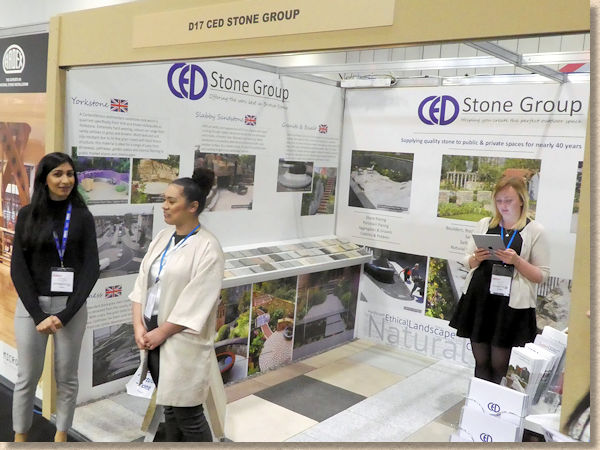
Parting thoughts:
The Stone Show is not the most expensive place to exhibit, so it’s disappointing to see such a poor show from those intermediaries. This is Britain’s showcase for the stone industry and it should be about more than sales: we should be showing the rest of the world that stone in Britain is a thriving, worthwhile and important part of our construction industry and our heritage.
I appreciate I’ve not mentioned companies such as Doulting Stone, Kentish Rag, Great Tew and so many others, but that’s solely because they don’t provide paving, or provide it as an occasional side-line. It’s not to devalue their contribution to the show, or the credibility of their products, it’s all down to time taken to write a review such as this, and the space needed to publish it.
Plenty of ancillaries to look at. Sealants from Dry Treat with the ever-effusive David Coster leading the way; more sealants from Lithofin, Delta and others; a great selection of mason’s tools from the US’s Trow & Holden; umpteen small suppliers of cutting discs, grinding tools, laser etchers; and some enormous CNC machines that take up more space than my house and probably cost even more!
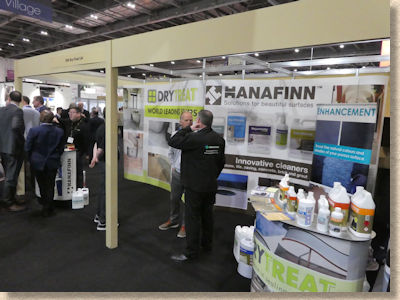
A good support role played throughout by the Stone Federation handing out free expertise, explanatory leaflets and booklets, squeezy rocks (which my grandchildren love!) and general bonhomie in a massively understated way. They also gave full support to the extensive ‘conference’ programme, which, while being extensive, had no real coverage of paving or streetmasonry, so can’t be referred to as ‘comprehensive’. I know paving forms but a small part of the global market for stone, but surely it’s a subject worth of *some* coverage?
One eminently obvious ‘development’ since the last outing for the Natural Stone Show is the plethora of porcelain being exhibited. Is it right to think of porcelain as a stone? It’s made from all natural materials, they say. But so is concrete. Ah! But it’s fired in a kiln, they retort. Like clay pavers, I ask?
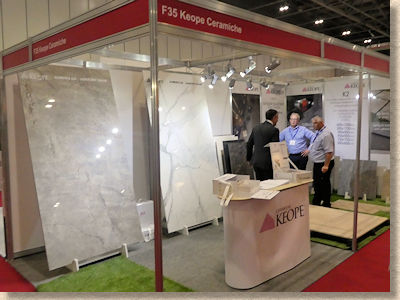
I suspect this is less a move to bring porcelain under the umbrella of natural stone and more a commercial pressure to fill potentially empty stands with the current ‘in-thing’ which has a comparatively generous marketing budget.
There’s nowt specifically wrong with porcelain paving . It’s a damned fine material, but, for my money, it is not stone. It’s a manufactured product created by combining disparate aggregates, so it has more in common with concrete. If porcelain is to be admitted, it becomes harder to say no to concrete, particularly those concretes which go to great lengths (often with great success) to mimic natural stone.
One other observation deserving comment is the sheer number of industry faces to be seen wandering around the show while not actively participating. At one time, I propped myself up against a litter bin at a crossroads between a busy vertical aisle and a horizontal corridor, and stood there for well over half an hour while face after face ‘bumped’ into me and stopped for a chat. I probably spent more time talking with non-exhibitors (should I call them ‘visitors’?) that with exhibitors.
Networking, as it’s called, has always been an essential part of any trade show, but it seemed to me that networking was, by some way, the biggest contributor to overall satisfaction at this instalment of The Stone Show. As interesting and entertaining as the exhibitors may be, it’s the quality of the people you meet wandering the aisles and corridors that makes this a worthwhile show.
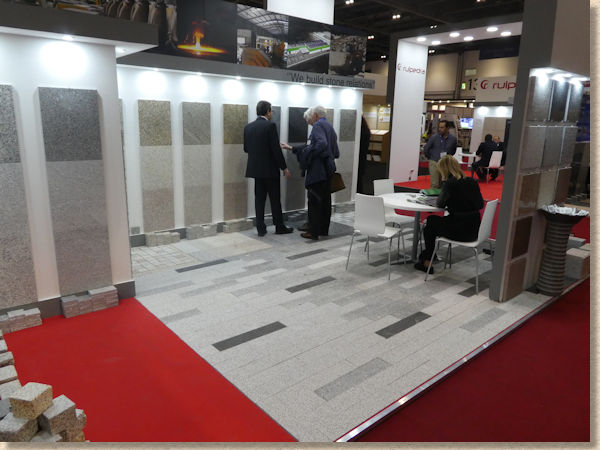
I don’t doubt for a second that I’ll be there again, in 2019, grumbling about the journey out to Docklands, and the price of a cuppa in the hall, because there’s nothing quite like the Stone Show. It would be great to see more of the British quarries represented, especially those knocking out paving, and it would please me no end to see a wider representation of the intermediaries who keep the wheels turning for our trade. They know who they are, the ones who claim to be big players in the Stone Trade, but who, sadly, can’t find a few quid in their marketing budget to promote the wider value of the stone trade to British trade, both nationally and internationally.

